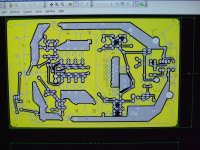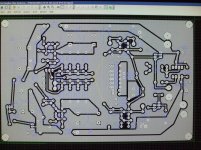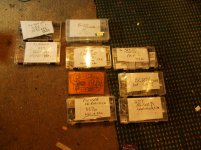Thinking of it, here is my list of possible improvements I was brainstorming with myself. Are they all significant and worthwhile? Maybe not. But we all are not here to produce a cost-effective piece of industrial equipment, this is supposed to be wild , crazy fun
Interested in what you guys think......
Symmetrical output – Not straightforward in this circuit. But with an inverting buffer (gain = -1) in parallel to the existing buffer this could be done. Advantage would be if the rest of the chain is symmetrical.
Relais on board for switching the input impedance – Nice to have, allows a cleaner build. Not everybody wants that flexibility, though.
Balance adjustment +/-2dB in 0.25dB steps – Most cartridges have a slight channel imbalance, and that way that could be taken care of straight away. Misaligning the cartridge in the tonearm may swamp that effect, though, so this is mostly for the precision fanatics. I am trying this now in another build, lets see.....
Different settings for the RIAA components – Interesting for those who have older records. Can easily be done with the Paradise as it is today, using the „Ext RIAA“ Connector.
Volume adjustment – would allow for connecting it straight to a power amplifier and have the shortest possible signal path. Guess thats another nice-to-have.
Input stage heatsink – many have done this (or similar), and that has a positive impact on drift and offset. Paper or cardboard is good enough to avoid airflow around the input stage transistors. Better would be a little piece of aluminum with holes where the TO92 packages would fit, mechanically fixed to the PCB. (Yes I am an engineer.) Another way would be to implement the input stage on a separate PCB and put it in silicone oil or similar.... Cooling it down with a Peltier element doesnt help much, for a significant reduction in noise it would have to go down to 60°K absolute temp (Joachim calculated this once, I believe).
Headphone output – This should of course be in conjunction with the volume adjustment. Can't get any shorter.....
RC combination in parallel to the input electrolytics – This is a more esoteric adjustment which I determined from simulating the input stage with its parasitic inductances as present in the current PCB. Ttied it in my build, didnt make a difference. But I may be able to not hear it.
Mute switch – that comes in handy when changing records. Its not as easy as shorting the output, though, as this will disturb the servo. More thought required.....
Demagnetizer circuit – that would be an add-on (and I know these can be bought separately), but I have seen at least one phono stage that has it built-in. I am using another trick – shorting the output of the cartridge and playing a few records helps a lot.
Servo with 3-pole compensation – That will speed it up significantly, and at the same time have less impact on the music signal. Calculated but not tried yet.
Switchmode power supply – This has been shown to reduce noise coming from the grid quite significantly. It would replace the pre-reg, and still sit in a separate case, away from the Paradise.
Battery supply – Alternative to the switchmode power supply.
Vibration isolation – From all reports I have heard, the Paradise builds are not microphonic. But it doesnt hurt to mount it hanging in springs, with a heavy stone or copper platter, in a closed case, so that no noise from the outside can get in (of course, implementing proper electrical shielding too....)
Symmetrical output - Would you please elaborate on this principle (-1 gain buffer) - seems too simple to be true and a major upgrade for those who have balanced preamps and amps.
Demagnetizer circuit – I am using another trick – shorting the output of the cartridge and playing a few records helps a lot.
I did connect cart outputs in reverse (+ to -) using an inversed RCA plug and it worked wonderfully.
Servo with 3-pole compensation – More lessons I will need to understand the principle.... good.
Switchmode power supply – This has been shown to reduce noise coming from the grid quite significantly. - Have been experimenting with that but inconclusive.... food for thought.
I went so far as etching the boards then house move so not even unpaked Fifi
But if some one want to take this up I can send the Gerbers (Whit Circuit owner permission)
What is it ?
Paradise circuit what else ?
See group of 4 transistors for thermal and shorth signal tracks.
Is single layer so same compromises whit a few external jumpers (2 yelow wires)
Yelow board has original components names
See group of 4 transistors for thermal and shorth signal tracks.
Is single layer so same compromises whit a few external jumpers (2 yelow wires)
Yelow board has original components names
Attachments
Last edited:
Symmetrical output - Would you please elaborate on this principle (-1 gain buffer) - seems too simple to be true and a major upgrade for those who have balanced preamps and amps.
Servo with 3-pole compensation – More lessons I will need to understand the principle.... good.
Switchmode power supply – This has been shown to reduce noise coming from the grid quite significantly. - Have been experimenting with that but inconclusive.... food for thought.
Hi Ricardo,
-1 gain buffer would be great, but so far I have not had a simple yet elegant and well-performing circuit idea how to do it (except using an opamp or transformer, of course.....)
the servo in the Paradise (as well as most other servos I have seen ) are simple inverting lowpass filters, with one time constant (pole) and consequently a -6dB/octave roll-off. When you make the filter transfer function more complex (2 or 3 poles), the roll-off is steeper, so the corner frequency can be elevated somewhat (letting the servo react faster) while the impact onthe audio band is reduced. You could even go to 5 or more poles, but that requires high precision passive components to work well.
SMPS - I built a switching power supply where I investigated the impact of various shield configurations (among other stuff) and published this in "Elektronik" (a german publication) in 2011. The rights are with them so I cannot publish this here, but I will try and find a link. Its in german though. The output noise of that power supply is significantly lower than most linear power supplies. That does not mean it sounds better...
Paradise circuit what else ?
See group of 4 transistors for thermal and shorth signal tracks.
Is single layer so same compromises whit a few external jumpers (2 yelow wires)
Yelow board has original components names
looks good! would be interesting to build and find out if it performs any different. The input stage looks very nice and compact.
Hi,

jauu
Calvin
Hesener, have a look at my preamp buffer thread #171 and 172-1 gain buffer would be great, but so far I have not had a simple yet elegant and well-performing circuit idea
jauu
Calvin
HeheHi,
Hesener, have a look at my preamp buffer thread #171 and 172
jauu
Calvin
the servo in the Paradise (as well as most other servos I have seen ) are simple inverting lowpass filters, with one time constant (pole) and consequently a -6dB/octave roll-off. When you make the filter transfer function more complex (2 or 3 poles), the roll-off is steeper, so the corner frequency can be elevated somewhat (letting the servo react faster) while the impact onthe audio band is reduced. You could even go to 5 or more poles, but that requires high precision passive components to work well.
That seems to be a really good idea.... can we do it on top of what exists in the paradise ?
There is quite a bit of space left on board especially around the servo and a 2-chip affair like the one I published years ago on MPP tread may do the tricklooks good! would be interesting to build and find out if it performs any different. The input stage looks very nice and compact.
But is it going to be needed when thermal coupling and separate supply with Kelvin returns may be just the ticket?
Eventually I will get around to drill those boards and from there idiot proofing and tidy up winter is coming so one will stop pottering around the garden soon
As I said If any one want to take this up ...
Attachments
Hi,
Hesener, have a look at my preamp buffer thread #171 and 172
jauu
Calvin
yes, that is a great circuit. I have seen it already but forgot... sorry! now if only we could get rid of that coupling cap...
different links, both point to the same post..
Only for you, not for others.
Here is the explanation for the link problem (hopefully with a correct link...):
http://www.diyaudio.com/forums/foru...-correct-posts-per-page-work.html#post3563389
http://www.diyaudio.com/forums/foru...-correct-posts-per-page-work.html#post3563389
I was actually asking about the ones not in the shunt. I use J113 in that location.
You mean Frans Graphs whit different Jfets ?and resistor values
Where is is now?
Tanks Frans
(I am sure he is going to post it again)
- Home
- Source & Line
- Analogue Source
- Paradise Builders


